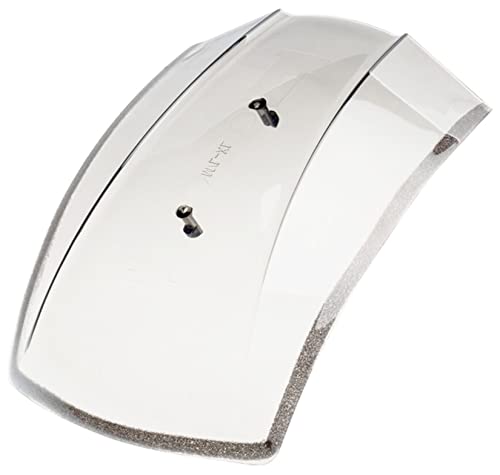Yep. I think the WORST of 'em going bad is from exposure to UV rays... after all, they're plastic. If one could cut glass, fit 'em tight, and find some quality epoxy that won't be eaten by DOT brake fluid, that'd be the way to go...
I've never seen a motorcycle with hydraulic drum brakes... but... I've seen a SIDECAR with hydraulic drum brake.
I had an '80 Sportster with hydraulic disk in the rear... but all my others have mechanical drum... and frankly, that was more than sufficient IMO, because when I really need to stop, there's only one (front) tire on the ground... at that point, a rear brake is totally moot.
Back to the blackboard:
The important thing to understand about brakes, and particularly... hydraulic brakes, is that the whole point of it, is to turn the kinetic energy of a rolling motorcycle... into HEAT.... and that's all brakes do.
I could run through the energy calculation process and demonstration that I used for the ACELA high speed trainset, but it'd take lots of whiteboard that doesn't exist here, but the principles are what's really important:
If you're a 900lb motorcycle, travelling at 100 feet per second, the kinetic energy is simple: Energy = Mass times Velocity squared...
900 x 100 x 100 = 9 million foot pounds per second
(I used pounds, because I started with 900 pounds, and I used feet and seconds, because the velocity is in seconds!)
that means, if I were to stop the motorcycle in JUST ONE SECOND, the force would be 9 million pounds.
Seems like alot, doesn't it? 100 feet per second is... 68.18mph. (think about that when you're texting... 3 seconds is... a football field )
Let's see what that really amounts to in horsepower. One horsepower is 33,000ft-lbs per MINUTE.
So take 9000000, divide by 60... that's 150,000ft-lbs per minute. Divide that by 33000, and it's... 4.5 horsepower... for ONE MINUTE.
Let's say you make that stop in 4 seconds... that's 1/15th of a minute... so 4.5 * 15... that's 67.5hp absorbed by the braking system. Doesn't seem like much, does it? 1hp/min = 42.41 btu/min... that means your 4 second braking yields 67.5*42.41= 2862.675 BTU (British Thermal Units) of energy.
Now, one BTU is the amount of energy it takes to raise one pound of water, one degree farenheit.... and in the case of the above, that's happening in FOUR SECONDS. One gallon of water is 8lbs... that means 2862/8 = 358 degrees in that same four seconds.
Let's say that front brake disk was water, and weighs 8lbs... it'll see a 358 degree rise in four seconds... if it starts at 60F, it'll be 358+60= 417 degrees once you're stopped.
Are we tired of math yet?
I've never seen a motorcycle with hydraulic drum brakes... but... I've seen a SIDECAR with hydraulic drum brake.
I had an '80 Sportster with hydraulic disk in the rear... but all my others have mechanical drum... and frankly, that was more than sufficient IMO, because when I really need to stop, there's only one (front) tire on the ground... at that point, a rear brake is totally moot.
Back to the blackboard:
The important thing to understand about brakes, and particularly... hydraulic brakes, is that the whole point of it, is to turn the kinetic energy of a rolling motorcycle... into HEAT.... and that's all brakes do.
I could run through the energy calculation process and demonstration that I used for the ACELA high speed trainset, but it'd take lots of whiteboard that doesn't exist here, but the principles are what's really important:
If you're a 900lb motorcycle, travelling at 100 feet per second, the kinetic energy is simple: Energy = Mass times Velocity squared...
900 x 100 x 100 = 9 million foot pounds per second
(I used pounds, because I started with 900 pounds, and I used feet and seconds, because the velocity is in seconds!)
that means, if I were to stop the motorcycle in JUST ONE SECOND, the force would be 9 million pounds.
Seems like alot, doesn't it? 100 feet per second is... 68.18mph. (think about that when you're texting... 3 seconds is... a football field )
Let's see what that really amounts to in horsepower. One horsepower is 33,000ft-lbs per MINUTE.
So take 9000000, divide by 60... that's 150,000ft-lbs per minute. Divide that by 33000, and it's... 4.5 horsepower... for ONE MINUTE.
Let's say you make that stop in 4 seconds... that's 1/15th of a minute... so 4.5 * 15... that's 67.5hp absorbed by the braking system. Doesn't seem like much, does it? 1hp/min = 42.41 btu/min... that means your 4 second braking yields 67.5*42.41= 2862.675 BTU (British Thermal Units) of energy.
Now, one BTU is the amount of energy it takes to raise one pound of water, one degree farenheit.... and in the case of the above, that's happening in FOUR SECONDS. One gallon of water is 8lbs... that means 2862/8 = 358 degrees in that same four seconds.
Let's say that front brake disk was water, and weighs 8lbs... it'll see a 358 degree rise in four seconds... if it starts at 60F, it'll be 358+60= 417 degrees once you're stopped.
Are we tired of math yet?









































